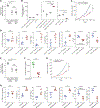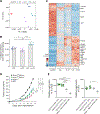Endogenous Glucocorticoid Signaling Regulates CD8+ T Cell Differentiation and Development of Dysfunction in the Tumor Microenvironment
- PMID: 32937153
- PMCID: PMC7682805
- DOI: 10.1016/j.immuni.2020.08.005
Endogenous Glucocorticoid Signaling Regulates CD8+ T Cell Differentiation and Development of Dysfunction in the Tumor Microenvironment
Abstract
Identifying signals in the tumor microenvironment (TME) that shape CD8+ T cell phenotype can inform novel therapeutic approaches for cancer. Here, we identified a gradient of increasing glucocorticoid receptor (GR) expression and signaling from naïve to dysfunctional CD8+ tumor-infiltrating lymphocytes (TILs). Conditional deletion of the GR in CD8+ TILs improved effector differentiation, reduced expression of the transcription factor TCF-1, and inhibited the dysfunctional phenotype, culminating in tumor growth inhibition. GR signaling transactivated the expression of multiple checkpoint receptors and promoted the induction of dysfunction-associated genes upon T cell activation. In the TME, monocyte-macrophage lineage cells produced glucocorticoids and genetic ablation of steroidogenesis in these cells as well as localized pharmacologic inhibition of glucocorticoid biosynthesis improved tumor growth control. Active glucocorticoid signaling associated with failure to respond to checkpoint blockade in both preclinical models and melanoma patients. Thus, endogenous steroid hormone signaling in CD8+ TILs promotes dysfunction, with important implications for cancer immunotherapy.
Keywords: CD8(+) T cell; Nr3c1; TCF-1; cancer; dysfunction; exhaustion; glucocorticoid; immune checkpoint blockade; steroid; tumor-associated macrophages.
Copyright © 2020 Elsevier Inc. All rights reserved.
Conflict of interest statement
Declaration of Interests A.C.A. is a member of the SAB for Tizona Therapeutics, Compass Therapeutics, Zumutor Biologics, and Astellas Global Pharma Development, which have interests in cancer immunotherapy. V.K.K. is a member of the SAB for Astellas Global Pharma Development and has an ownership interest and is a member of the SAB for Tizona Therapeutics. A.R. and V.K.K. are co-founders of and have an ownership interest in Celsius Therapeutics. A.C.A.’s and V.K.K.’s interests were reviewed and managed by the Brigham and Women’s Hospital and Partners Healthcare in accordance with their conflict of interest policies. M.B. is a consultant for Eli Lilly and Company. A.R. is also an SAB member for Thermo Fisher, Neogene Therapeutics, Asimov, and Syros Pharmaceuticals and is an equity holder in Immunitas. A.R.’s interests were reviewed and managed by the Broad Institute and HHMI in accordance with their conflict of interest policies. A provisional patent application was filed including work in this manuscript.
Figures







Comment in
-
Not Sweet: Glucocorticoids from Intratumoral Myeloid Cells Disable T Cells.Immunity. 2020 Sep 15;53(3):476-478. doi: 10.1016/j.immuni.2020.08.007. Immunity. 2020. PMID: 32937147
References
-
- Abbaszade IG, Clarke TR, Park CH, and Payne AH (1995). The mouse 3 beta-hydroxysteroid dehydrogenase multigene family includes two functionally distinct groups of proteins. Mol Endocrinol 9, 1214–1222. - PubMed
-
- Arbour KC, Mezquita L, Long N, Rizvi H, Auclin E, Ni A, Martinez-Bernal G, Ferrara R, Lai WV, Hendriks LEL, et al. (2018). Impact of Baseline Steroids on Efficacy of Programmed Cell Death-1 and Programmed Death-Ligand 1 Blockade in Patients With Non-Small-Cell Lung Cancer. J Clin Oncol 36, 2872–2878. - PubMed
-
- Arriza JL, Weinberger C, Cerelli G, Glaser TM, Handelin BL, Housman DE, and Evans RM (1987). Cloning of human mineralocorticoid receptor complementary DNA: structural and functional kinship with the glucocorticoid receptor. Science 237, 268–275. - PubMed
-
- Auphan N, DiDonato JA, Rosette C, Helmberg A, and Karin M. (1995). Immunosuppression by glucocorticoids: inhibition of NF-kappa B activity through induction of I kappa B synthesis. Science 270, 286–290. - PubMed
Publication types
MeSH terms
Substances
Grants and funding
LinkOut - more resources
Full Text Sources
Other Literature Sources
Medical
Molecular Biology Databases
Research Materials

